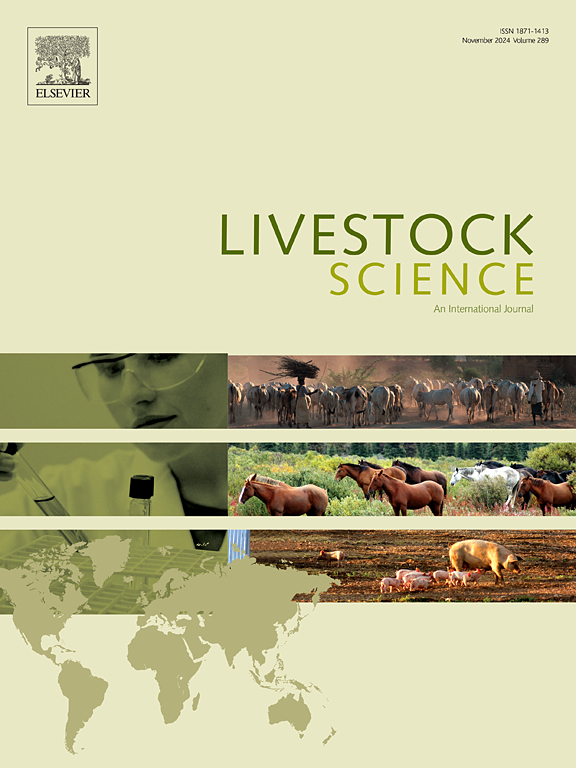Impact of climate change on the productivity and adaptation of Ethiopia's Bonga and Menz sheep breeds
IF 1.9
3区 农林科学
Q2 AGRICULTURE, DAIRY & ANIMAL SCIENCE
引用次数: 0
Abstract
This study aimed to derive novel phenotypes of sheep resilience and response to climate change, to estimate genetic parameters for novel phenotypes, and to evaluate the genetic correlation of resilience indicator traits with economically important traits. This study used the 14 years (2009–2022) of productive, reproductive, pedigree, and climate data to derive resilience and stability phenotypes using a random regression model fitting to the reaction norm function and genetic parameter estimates were estimated from a linear mixed model. The changes in productive and reproductive performance of both sheep breeds in response to environmental descriptors ((temperature-humidity index (THI) and rainfall (RF)) were found to be minimal and not significantly (P > 0.05) different from zero, suggesting that most of these traits showed stable performance independent of THI and RF. The direct heritability (h2) estimate (0.101–0.163) for the resilience of Bonga sheep in terms of weight gain, Kleiber ratio (KR), total lamb birth weight, and annual reproduction rate (ARR) indicated the presence of substantial genetic variance. Nevertheless, the h2 for resilience and stability phenotypes of Bonga sheep in terms of other reproductive traits were found to be low (0.0001 – 0.098). The highest h2 for resilience of Menz sheep was observed for total lamb weaning weight (0.416), followed by body weight (0.145), KR (0.114), and ARR (0.110). The genetic progress of THI-based resilience was favorable for most of the traits of Bonga sheep. The genetic trend for rainfall-based resilience for most productive and reproductive traits of Menz sheep was genetically decreasing slightly. In conclusion, the influence of heat stress and rainfall on the performance of both sheep breeds is minimal. But different lambs and ewes react differently to a changing climate, and there is some level of genetic contribution to the variability of reaction for some traits. This suggests the possibility of improving the resilience of sheep to weather variation through within-breed selection to sustain these sheep breeds' optimal production and reproduction performances in changing climate conditions, although the influence is minimal. Besides, the contribution of the environment to phenotypic variation of resilience and stability phenotypes was high for most traits, which calls for management intervention to enhance sheep resilience to climate change.
气候变化对埃塞俄比亚Bonga和Menz羊品种生产力和适应性的影响
本研究旨在建立绵羊恢复力和气候变化响应的新表型,估计新表型的遗传参数,并评估恢复力指标性状与重要经济性状的遗传相关性。本研究使用了14年(2009-2022)的生产、繁殖、谱系和气候数据,使用拟合反应规范函数的随机回归模型得出了弹性和稳定性表型,并从线性混合模型估计了遗传参数。两个羊品种的生产和繁殖性能对环境描述符(温湿度指数(THI)和降雨量(RF))的响应变化很小,而且不显著(P >;0.05),不同于零,说明这些性状的表现与THI和RF无关。在增重、克莱伯比(KR)、羔羊总初生重和年繁殖率(ARR)方面,奉嘎羊恢复力的直接遗传力(h2)估计值(0.101 ~ 0.163)表明存在较大的遗传变异。然而,在其他生殖性状方面,邦加羊的弹性和稳定性表型的h2较低(0.0001 ~ 0.098)。羔羊断奶总重(0.416)对恢复力的影响最大,其次是体重(0.145)、KR(0.114)和ARR(0.110)。以thi为基础的抗逆性遗传进展有利于邦加羊的大部分性状。门兹羊大部分生产和繁殖性状的降雨恢复力遗传趋势略有下降。综上所述,热应激和降雨对两个羊品种生产性能的影响很小。但不同的羔羊和母羊对气候变化的反应不同,某些性状的反应差异在某种程度上是由遗传造成的。这表明有可能通过品种内选择来提高羊对气候变化的适应能力,以维持这些羊品种在不断变化的气候条件下的最佳生产和繁殖性能,尽管影响很小。此外,环境对大多数性状的恢复力和稳定性表型变异的贡献很大,需要管理干预来增强绵羊对气候变化的适应能力。
本文章由计算机程序翻译,如有差异,请以英文原文为准。
求助全文
约1分钟内获得全文
求助全文
来源期刊

Livestock Science
农林科学-奶制品与动物科学
CiteScore
4.30
自引率
5.60%
发文量
237
审稿时长
3 months
期刊介绍:
Livestock Science promotes the sound development of the livestock sector by publishing original, peer-reviewed research and review articles covering all aspects of this broad field. The journal welcomes submissions on the avant-garde areas of animal genetics, breeding, growth, reproduction, nutrition, physiology, and behaviour in addition to genetic resources, welfare, ethics, health, management and production systems. The high-quality content of this journal reflects the truly international nature of this broad area of research.
 求助内容:
求助内容: 应助结果提醒方式:
应助结果提醒方式:


